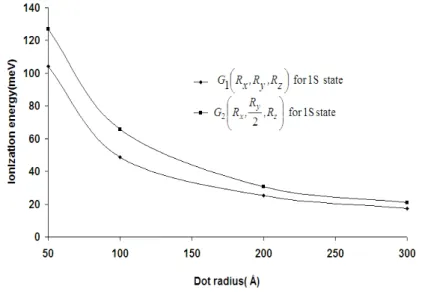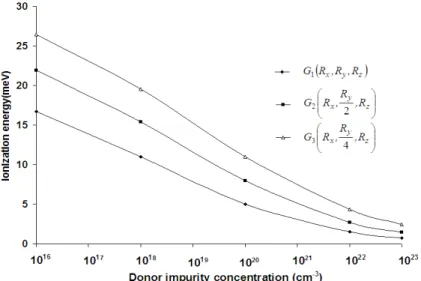1041
PACS numbers: 73.21.La, 71.55 – i, 73.61.Ey, 71.30. + h.
SIMULTANEOUS EFFECTS OF HYDROSTATIC PRESSURE AND GEOMETRY ON METAL-INSULATOR TRANSITION IN A CUBICAL
QUANTUM DOT
S. Rajashabala1, R. Kannan2
1 School of Physics, Madurai Kamaraj University, palkalainagar,Madurai-625021,Tamilnadu,India. E-mail: rajashabala@yahoo.com
2 Department of Physics, Anna University of Technology Madurai, Dindigul Campus, Dindigul-624622, India
The ionization energies of a hydrogenic donor in a GaAs- Ga1-xAlxAs cubical quantum dot system are obtained for various cross-sectional geometries. We have investigated the metal -insulator transition in such a system by considering the simultaneous effects of pressure and geometry. It is observed that, the ionization energies are increased due the geometry effect. Consecutively, the metal insulator transition couldn’t occur for lower concentration of donor impurities. We present the results for infinite confinement.
Keywords: HYDROGENIC DONOR, DONOR BINDING ENERGY, METAL-INSU-LATOR TRANSITION, QUANTUM DOT AND CROSS- SECTIONAL GEOMETRY.
(Received 04 February 2011)
1. INTRODUCTION
In the last few decades, there has been considerable interest in the study of impurity states in low dimensional quantum well systems due to their impending applications in electronic and optoelectronic devices [1-3]. The binding energy of shallow donor impurities in nanoscopic systems depends on materials, geometry, size and shape [4, 5]. The position of the impurity has a strong influence [6]. Schweizer et al. [7] have produced rectangular transversal section GaAs-(Ga, Al)As quantum well wires and quantum dots. The more real zero dimensional quantum hetero structure (cubic dot) was studied by Ribeiro and Latg´e [8]. Oyoko et al. [9] studied donor impurities in a parallelepiped-shaped GaAs-(Ga, Al)As quantum dot. Kasapoglu et al. have studied the geometrical effects on shallow donor impurities in quantum well wire [10]. Jeyakumar et al. have investigated the effect of geometry on diamagnetic susceptibility of a hydrogenic donor in GaAs-(Ga, Al)As systems[11].
influence of simultaneous effects of hydrostatic pressure and geometry on the MIT in a GaAs cubical quantum dot has not been reported.
This paper has been organized as follows. In Section2, the model and calculations is described. The Results and discussion is given in Section 3. Finally, a brief conclusion is given in Section 4.
2. MODEL AND CALCULATIONS
The Hamiltonian for a screened donor impurity in a GaAs cubical quantum dot is given by
2 2 2
( ) ( )
2 D
e
H V r
r r m* e - Ñ
= h - + (1)
where m* is the effective mass of the donor electron in GaAs dot and e(r) is
the dielectric screening function. The second term in Eqn.(1) which is responsible for the phase transition. We assume Thomas-Fermi dielectric screening function, which can be written as
1 ( ) r e r l e e -= (2)
Here l is screening parameter, which is related with density of states [n(x)] at Fermi energy is given by,
2 2 4pe n( )x l
e
= (3)
The third term in Eqn.(1) which confines the donor electron within the quantum dot. The confining potential is given by
( )
0 , ,2 2 2
otherwise y x z D R R R
x y z
V r ì £ £ £ ï = í ï¥ î (4)
Here Rx, Ry and Rz give the dimension of the system along x, y and z axes.
The ground state wave function for Hamiltonian (H) can be written as
2 2 2
cos cos cos , ,
2 2 2
0 otherwise y
x y z x z
x y z
R
R R
x y z
N e x y z
R R R
a
p p p
y - + +
ì æ ö æ ö æ ö £ £ £
ï ç ÷ çç ÷÷ ç ÷
= í è ø è ø è ø
ï î
(5)
where N is the normalization constant and a is the variational parameter. The Schrodinger equation is solved by variational method and the áHñ can be written as
áHñ=áTñ + áVñ + áVD(r)ñ (6)
áTñ=
( )
22 2 2 2
0 0 0
8
2 * 0.067 y x R z
R R N dxdydz a y y -Ñ
ò ò ò (7)
The expectation of impurity potential energy is given by
( )
2( )
2 2 2 22 2 2
0 0 0
8
(8) 12.65
y x R z
R R
D
N
V r dxdydz
x y z
a y y
- Ñ
=
+ +
ò ò ò (8)
The expectation of confining potential energy is áVD(r)ñ = 0. To obtain the
ionization energy, H is minimized with respect to a and is calculated by using the following formula.
min
ion sub
E =E - H (9)
where Esub is the sub band energy which is calculated from the following
formula for different dot geometries.
2 2 2 2 2 * sub
x y z
E
m R R R
p p p
éæ ö æ ö æ ö ù
ê ú
= ç ÷ +çç ÷÷ +ç ÷ êè ø è ø è ø ú
ë û
h (10)
2.1 Effect of hydrostatic pressure
Application of hydrostatic pressure modifies dot size, dielectric constant and effective mass in the following way [14].
4 0(1 2.6694 10 )
R=R - × - P , e( )P =12.65-0.088P, m P*( )=m*(0) exp(0.078 )P ,
where P is expressed in GPa.
Using these variations the binding energy and the donor ionization energies of dot were obtained for 30 Kbar pressure using the variational method as explained above.
The effect of the diamagnetic susceptibility (cdia) of a hydrogenic donor
is calculated by using the following formula [15].
2 2 * 2 6 dia e r m c c e -=
where c is the velocity of light (which is equal to 137au and e= 1 in atomic units), and ár2ñ is the mean square distance of donor electron from the donor
ion. By making use of previous results the cdia values for an infinite cubical
quantum dot are estimated. For infinite barrier model we use the expression,
( )
2 2 2 2 2 * 2
0 0 0
8
6
y x R z
R R dia N r dxdydz m c a
c y y
e
3. RESULTS AND DISCUSSION
The results obtained are shown in Figs. 1-4. The ionization energies of a hydrogenic donor in a cubical quantum dot for two different geometries such as G1(Rx, Ry, Rz) and G2(Rx, 0.5Ry, Rz) are presented in Fig. 1. It is
noticed that the donor ionization energy increases when the dimension of the system along y axis (Ry) is reduced by half. This is mainly due to the
compression of wave function. Also the donor ionization energy decreases as the dot size increases. This type of variation is common to all quantum well systems with infinite barriers [16].
Fig. 1- Variation of ionization energy with radius for two different geometries
The variation of ionization energy with donor impurity concentration is shown in Fig. 2 for an infinite cubical quantum dot with three different cross- sectional geometries namely G1(Rx, Ry, Rz), G2(Rx, 0.5Ry, Rz) and G3(Rx, 0.25Ry, Rz).Here the R is taken as 200 樔. The ionization energy
increases as the impurity concentration decreases. MIT (ionization energy goes to zero) takes place very quickly when there is no geometrical effect is included. It is concluded that as such the inclusion of geometrical effect has no vital role in the studies of MIT.
Fig. 2- Variation of donor ionization energy with concentration for three different geometries
Fig. 4 exhibits MIT through diamagnetic susceptibility of a donor in a GaAs-GaxAl1-xAs infinite cubical quantum dot of size R= 1000 樔 with the
geometry of G4(0.5Rx(P), Ry(P), Rz(P)).. As expected, cdia diverges at a
critical concentration (Nc).This trend is evident from Fig.4. It is observed
that MIT takes place at (Nc) of 1018 cm–3when pressure and geometry effects
are included. At present there are no experimental or theoretical results we couldn’t compare our results with the existing literature.
Table. 1 – Variation of effective mass, dielectric constant, and well size of GaAs with pressure
Sr. No
Pressure (Kbar)
m*(p) (a.u)
e (p) (a.u)
L (p) (a.u) L (0) = 1000 樔
1 2 3 4 5
0 10 20 30 40
0.067 0.0724 0.0783 0.0847 0.0915
12.65 11.77 10.89 10.01 9.13
Fig. 3 -Variation of donor ionization energy with concentration for three different conditions
a b
Fig. 4 -MIT through diamagnetic susceptibility (a), MIT through ionization energy (b)
4. CONCLUSION
In conclusion of this paper, we have investigated the metal insulator transition in GaAs-Ga1 – xAlxAs cubical quantum dot under simultaneous
investigation on simultaneous effects of hydrostatic pressure and geometry on metal-insulator transition in a GaAs cubical quantum dot will stimulate more experimental investigations on these aspects.
One of the authors (S.RS) thanks Prof. K. Navaneethakrishnan (Retd.) and Prof. K. Ramachandaran, School of Physics, Madurai Kamaraj University, Madurai, India, for their useful and valuable suggestions.
REFERENCES
1. M.J. Kelly, Low-Dimensional Semiconductors: Materials,Physics Technology,
Devices (Oxford: Clarendon: 1995) and references therein.
2. L. Jacak, P. Hawrylak, A. Wojs, Quantum Dots, (Springer-Verlag: Berlin
Heidelberg: 1998).
3. J.H. Davies, The physics of Low-Dimensional Semiconductors, an Introduction,
(Cambridge University Press: 1998).
4. F.J. Ribeiro, A. Latge, Phys. Rev. B50, 4913 (1994).
5. P.G. Bolcatto, C.R. Proetto, Phys. Rev. B59, 12487(1999).
6. J. Silva-Valencia, N. Porras-Montenegro, J. Appl. Phys. 81, 901 (1997).
7. H. Schweizer, G. Lehr, F. Prins, G. Mayer, E. Lach, R. Krüger, E. Fröhlich,
M.H. Pilkuhn, G.W. Smith, Superlattices Microstruct.12, 419 (1992).
8. F.J. Ribeiro, A. Latg´e, Phys. Rev.B50, 4913 (1994).
9. H.O. Oyoko, C.A. Duque, N. Porras-Montenegro, J. Appl. Phys. 90, 819 (2001).
10.E. Kasapoglu, H. Sari, I. Sokemen, Physica E 19, 332 (2003)
11.C. Rajamohan, A. Merwyn Jasper D. Reuben, P. Nithiananthi, K. Jayakumar, J.
Math. Chem.44, 743 (2008).
12.H.S. Yang, S. Santra, P.H. Holloway, J. Nanosci. Nanotech. 5, 1364 (2005).
13.Y.A .Yang, O.Chen, A.Angerhofer, Y.C. Cao, J. Am. Chem. Soc. 128, 12428
(2006).
14.S. Rajashabala, K. Navaneethakrishnan, Physica E40, 843 (2008).
15.M. Latha, S. Rajashabala, K. Navaneethakrishnan, phys. stat. sol. b 243, 1219
(2006).


